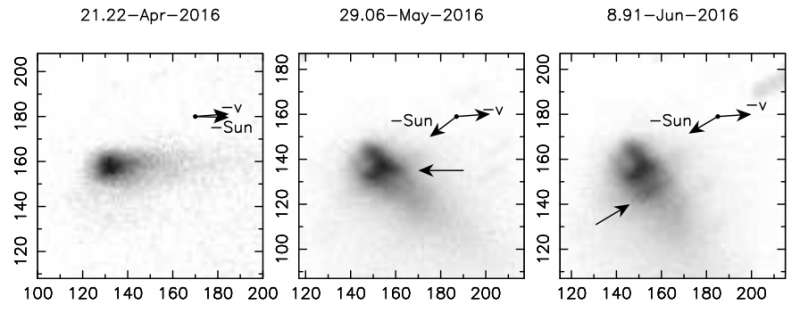July 19, 2016 report
Scientists study early evolution of activated asteroid P/2016 G1

(Phys.org)—A team of Spanish astronomers has recently observed a newly discovered asteroid designated P/2016 G1 (PANSTARRS), revealing its activity and measuring its total dust loss. The findings, detailing the most probable hypothesis that could explain the cause of this activity, were published July 12 on arXiv.org.
P/2016 G1 (PANSTARRS), or P/2016 G1 for short, was detected by R. Weryk and R. J. Wainscoat in April 2016 with the 1.8-m Pan-STARRS1 telescope in Hawaii. With an asteroid-like orbit, having a semimajor axis of about 2.85 AU and an eccentricity of 0.21, this body exhibits transient, comet-like activity. Therefore, the scientific community still argues whether objects like P/2016 G1 should be called "main-belt comets" (as they orbit the sun within the asteroid belt) or rather asteroids showcasing dust activity.
The real nature of these bodies could be revealed by detailed observations focusing on the processes taking place on their surfaces. For that reason, a team of researchers led by Fernando Moreno of the Institute of Astrophysics of Andalusia in Spain, started observing P/2016 G1 shortly after its discovery. They used the 10.4m Gran Telescopio Canarias (GTC) at the Roque de los Muchachos Observatory in La Palma, Canary Islands to observe the asteroid during three nights spanning from late April to June 8, 2016.
"Observations of P/2016 G1 were scheduled immediately after the discovery alert, within our long-term GTC program of activated asteroid observations. CCD images of P/2016 G1 have been obtained under photometric and excellent seeing conditions on the nights of April 20, May 28, and June 8, 2016," the scientists wrote in a paper.
From the GTC imaging data and the Monte Carlo dust tail modeling, the team was able to get insights on the asteroid's evolution and active processes. In particular, the model employed by the researchers computed the dust tail brightness of a comet or activated asteroid by adding up the contribution to the brightness of each particle ejected from the parent nucleus.
According to the team's observations and modeling, P/2016 G1 was activated about 350 days before perihelion (around Feb. 10, 2016). The activity had a duration of approximately 24 days and the total dust mass emitted from the asteroid was at least at a level of 17,000 tons.
This activity could be caused by various physical processes, including impact, thermal fracture, rotational instabilities and ice sublimation. However, due to the fact that P/2016 G1 is located in the inner region of the main belt and has a small semi-major axis, the researchers excluded ice sublimation as the possible driver of this activity.
The scientists concluded that the most probable explanation for this activity is an impact event that would have induced a partial destruction of the asteroid, emitting dust grains to space nearly isotropically while the body is being torn apart.
"We speculate that this dust ejection could be associated to an impact, and that the subsequent modeled activity is due to the asteroid partial or total disruption. The impact itself had produced the ejection of some 240 tons of dust," the paper reads.
The team also noted that if the impact scenario is true, the smaller fragments of the parent body could exist in the vicinity of the asteroid's dust cloud. However, deeper imaging of the object is needed to confirm this.
More information: arxiv.org/abs/1607.03375 Early evolution of disrupted asteroid P/2016 G1 (PANSTARRS) arXiv:1607.03375 [astro-ph.EP]
Abstract
We present deep imaging observations of activated asteroid P/2016 G1 (PANSTARRS) using the 10.4m Gran Telescopio Canarias (GTC) from late April to early June 2016. The images are best interpreted as the result of a relatively short-duration event with onset about 350+10−30 days before perihelion (i.e., around 10th February, 2016), starting sharply and decreasing with a 24+10−7 days (Half-width at half-maximum, HWHM). The results of the modeling imply the emission of ∼1.7×107 kg of dust, if composed of particles of 1 micrometer to 1 cm in radius, distributed following a power-law of index —3, and having a geometric albedo of 0.15. A detailed fitting of a conspicuous westward feature in the head of the comet-like object indicates that a significant fraction of the dust was ejected along a privileged direction right at the beginning of the event, which suggests that the parent body has possibly suffered an impact followed by a partial or total disruption. From the limiting magnitude reachable with the instrumental setup, and assuming a geometric albedo of 0.15 for the parent body, an upper limit for the size of possible fragment debris of ∼50 m in radius is derived.
© 2016 Phys.org




















